 Backend Development
Backend Development
 PHP Tutorial
PHP Tutorial
 How to set up a PHP development environment (Apache+PHP+MySQL) (with tutorial)
How to set up a PHP development environment (Apache+PHP+MySQL) (with tutorial)
How to set up a PHP development environment (Apache+PHP+MySQL) (with tutorial)
How should we set up a PHP development environment (Apache PHP MySQL) in a Windows environment? "Xiaobai" will take you to find out. Let's set off together! ! !

Install Apache
1. Download Apache, address: http://www.apachelounge.com/download/, as shown below: 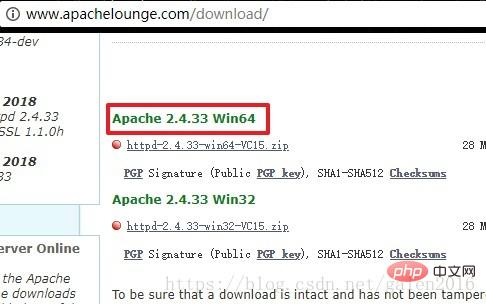
2. Unzip the compressed package. It is best to put it in the root directory of the disk, otherwise it is easy to report a path error during configuration. I changed the folder name here to facilitate future configuration, as shown below: 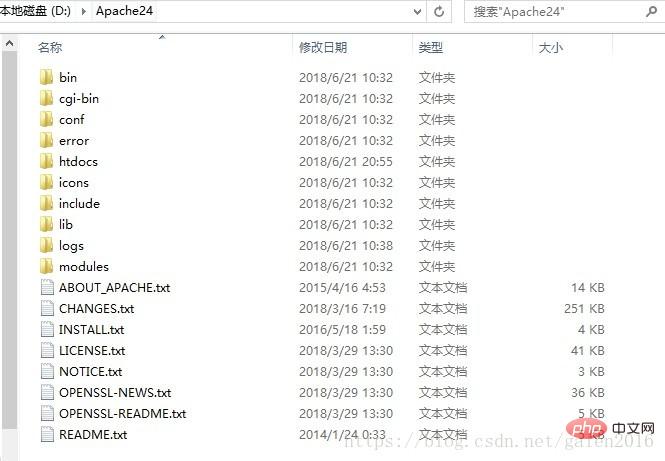
Install PHP
1. Download the PHP compressed package at: https://windows.php.net/download. I downloaded the PHP7.0 Thread Safe version, as shown below:
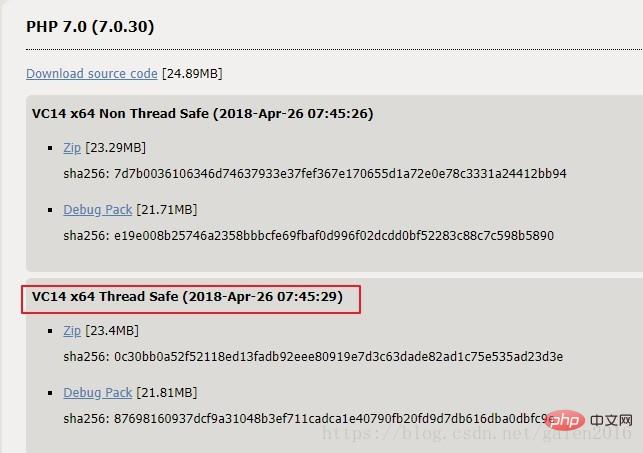
2. Unzip the compressed package. I unzipped it as follows: 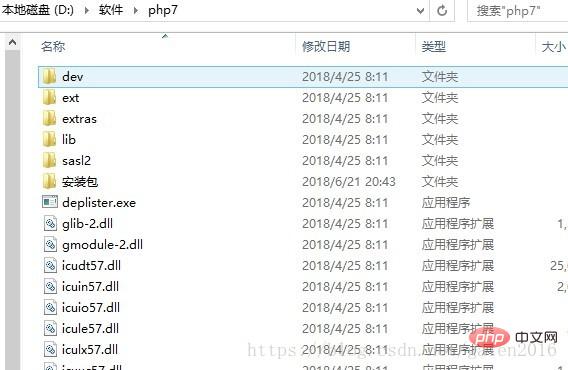
Install MySQL
1. The MySQL55 version I installed, MySQL will not be introduced here. For the installation method, you can search online
2. MySQL official download address: https://dev.mysql.com/downloads/installer/
3. MySQL default installation directory is as follows: 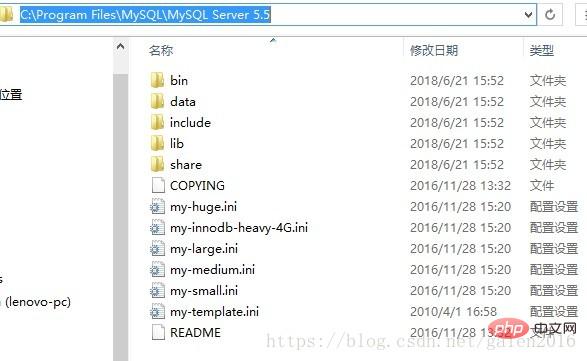
Configuring MySQL
1. Check in the environment variable page
The specific operations are as follows: My Computer-right-click-Properties-Advanced System Settings-Environment Variables
2. Create a new MYSQL_HOME variable, The value is the installation path of MySQL, as shown below: 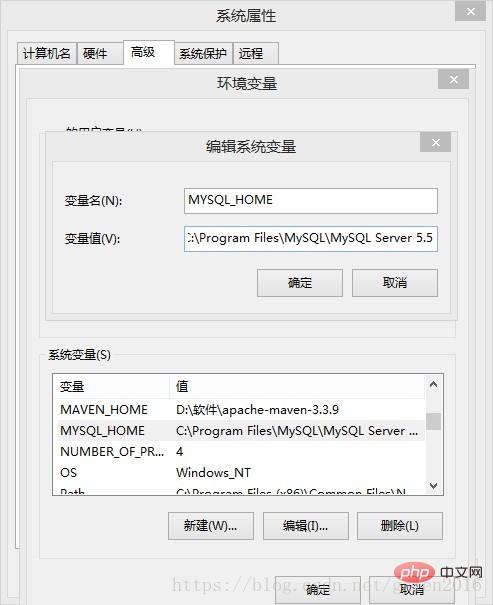
3. Edit the path system variable and add %MYSQL_HOME%\bin to the end of the path variable
4. Start MySQL and enter the command line: start mysqld, as shown below: 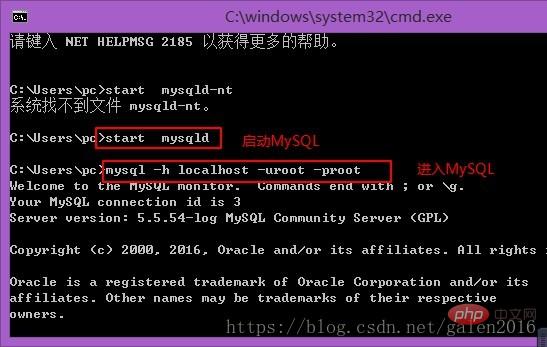
Configuring PHP
1. Open the PHP installation directory and copy php.ini-development first, and then copy php.ini- Development is changed to php.ini and saved
2. Open php.ini to modify the configuration and search for; extension_dir = “ext” and change it to extension_dir = “ext’s directory”, for example, extension_dir = “D:\Software\php7\ext” , as shown below: 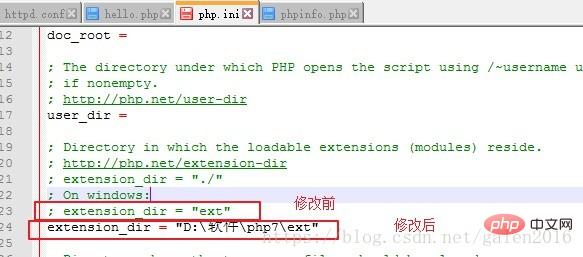
3. Open several commonly used extensions, for example: find extension=php_mysqli.dll and remove the preceding semicolon. Open the libraries in the picture below: 
Configuring Apache
1. Open the installation directory of Apache, find the httpd.conf file in the conf folder and open it
2. Find the "Define SRVROOT" item and change the value in the quotation marks to the installation directory of Apache, as shown below: 
3. Add support for PHP and The installation path of PHP is as shown below: 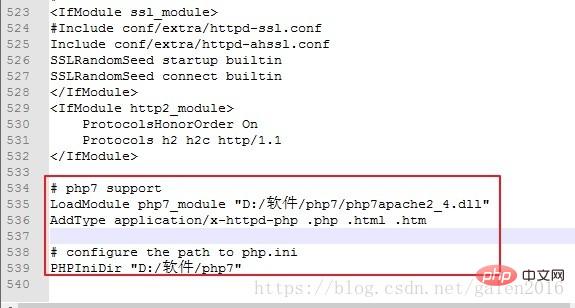
The code is as follows:
# php7 supportLoadModule php7_module "D:/软件/php7/php7apache2_4.dll"AddType application/x-httpd-php .php .html .htm# configure the path to php.iniPHPIniDir "D:/软件/php7"
Start the Apache service
1. Set environment variables
Right-click My Computer, Properties->Advanced, find the environment variables button at the bottom, select the current user's PATH variable, edit and create the following Entry:
D:\Apache24\bin
D:\Software\php7
D:\Software\php7\ext
2. Install apache service
Open the command line as an administrator, Execute httpd.exe -k install
3. Start the service
Find the bin folder in the installation directory of apache, double-click ApacheMonitor.exe, and apache will be started after double-clicking.
You can select the icon below in the taskbar, right-click to open the Apache Service Monitor window, and manage the Apache service 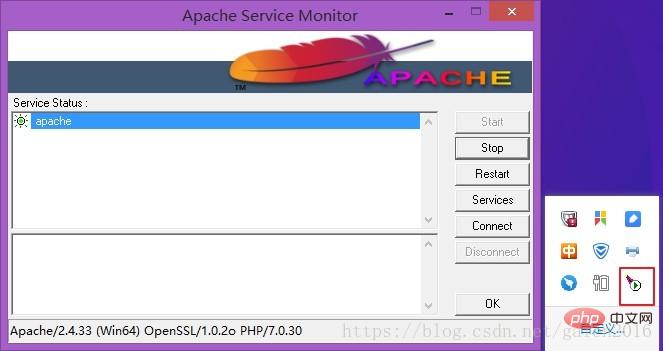
4. At this time, enter localhost in the browser address bar and press Enter. The apache interface appears, as shown below: 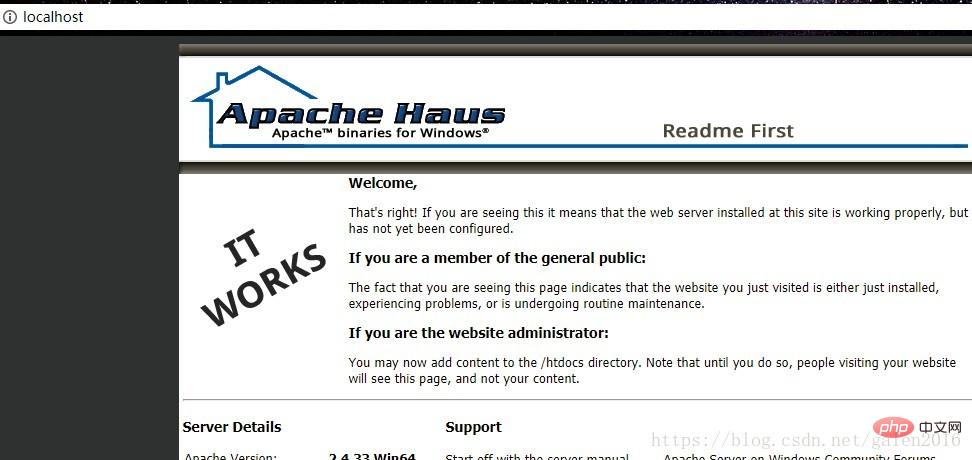
5. Next, create a new phpinfo.php file in the Apache installation directory/htdocs directory, with the content:
<?phpphpinfo();?>
After saving, Enter 127.0.0.1/phpinfo.php in the browser, press Enter, and the version information about PHP will appear, as shown below: 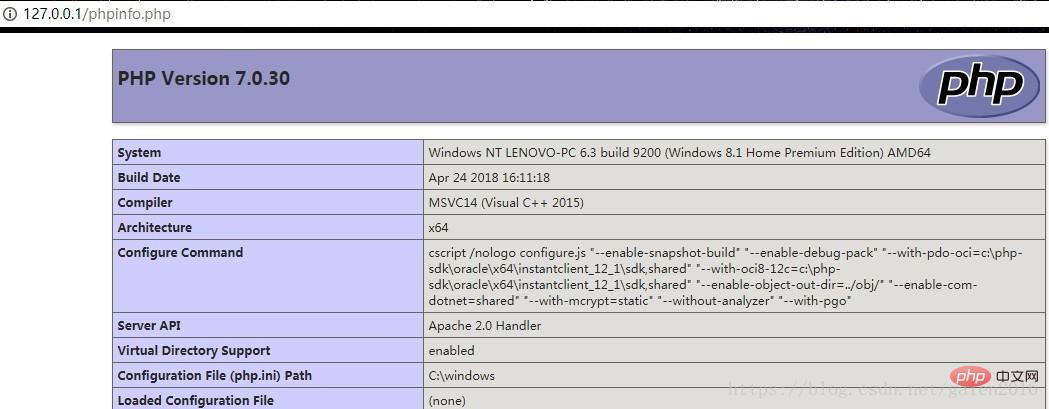
The PHP environment is now set up, and the PHP file can be Put it into the htdocs folder and run
Pitfalls
1. After the browser enters the corresponding PHP address, it cannot parse php
Solution: In the command Enter httpd -t to check if there is a startup problem with Apache , as shown below: 
You can see that the error message is that the php7apache2_4.dll file in the PHP installation directory cannot be found. After checking online, the PHP version I downloaded is wrong. I should download the Thread safe version.
Introduction: Summary in Windows environmentBuilding a PHP development environment (Apache PHP MySQL)
2. Unzip the compressed package. It is best to put it in the root directory of the disk, otherwise it is easy to report a path error during configuration. I have changed the folder name here to facilitate future configuration, as shown below: 
Install PHP
1. Download the PHP compressed package at: https://windows.php.net/download. I downloaded the PHP7.0 Thread Safe version, as shown below: 
2. Unzip the compressed package. I unzipped it as follows: 
Install MySQL
1. The MySQL55 version I installed, the installation of MySQL will not be introduced here. Method, you can search online
2. MySQL official download address: https://dev.mysql.com/downloads/installer/
3. MySQL default installation directory is as follows: 
Configuring MySQL
1. Check in the environment variable page
The specific operations are as follows: My Computer-right-click-Properties-Advanced System Settings-Environment Variables
2. Create a new MYSQL_HOME variable, value It is the installation path of MySQL, as shown below: 
3. Edit the path system variable and add %MYSQL_HOME%\bin to the end of the path variable
4. Start MySQL and enter: start on the command line mysqld, as shown below: 
Configure PHP
1. Open the PHP installation directory and copy php.ini-development first, then change php.ini-development to php.ini and save it
2. Open php. ini modify the configuration and search; extension_dir = "ext", change to extension_dir = "ext directory", for example extension_dir = "D:\Software\php7\ext", as shown below: 
3. Open several commonly used extensions, for example: find extension=php_mysqli.dll and remove the preceding semicolon. Open the libraries in the picture below: 
Configuring Apache
1. Open the installation directory of Apache, find the httpd.conf file in the conf folder and open it
2. Find the "Define SRVROOT" item and change the value in the quotation marks to the installation directory of Apache, as shown below: 
3. Add support for PHP and The installation path of PHP is as shown below: 
The code is as follows:
# php7 supportLoadModule php7_module "D:/软件/php7/php7apache2_4.dll"AddType application/x-httpd-php .php .html .htm# configure the path to php.iniPHPIniDir "D:/软件/php7"
Start the Apache service
1. Set environment variables
Right-click My Computer, Properties ->Advanced, find the environment variable button at the bottom, select the current user's PATH variable, edit and create the following entries:
D:\Apache24\bin
D:\Software\php7
D:\Software \php7\ext
2. Install the apache service
Open the command line as an administrator and execute httpd.exe -k install
3. Start the service
Find the bin folder in the apache installation directory , double-click ApacheMonitor.exe, and apache will start after double-clicking.
You can select the icon below in the taskbar, right-click to open the Apache Service Monitor window, and manage the Apache service 
4. At this time, enter localhost in the browser address bar and press Enter. The apache interface appears, as shown below: 
5. Next, create a new phpinfo.php file in the Apache installation directory/htdocs directory, with the content:
<?phpphpinfo();?>
After saving, Enter 127.0.0.1/phpinfo.php in the browser, press Enter, and the version information about PHP will appear, as shown below: 
The PHP environment is now set up, and the PHP file can be Put it into the htdocs folder and run
Pitfalls
1. After the browser enters the corresponding PHP address, it cannot parse php
Solution: In the command Enter httpd -t to check if there is a startup problem with Apache , as shown below: 
You can see that the error message is that the php7apache2_4.dll file in the PHP installation directory cannot be found. After checking online, the PHP version I downloaded is wrong. I should download the Thread safe version.
Recommended learning: "PHP Video Tutorial"
The above is the detailed content of How to set up a PHP development environment (Apache+PHP+MySQL) (with tutorial). For more information, please follow other related articles on the PHP Chinese website!

Hot AI Tools

Undresser.AI Undress
AI-powered app for creating realistic nude photos

AI Clothes Remover
Online AI tool for removing clothes from photos.

Undress AI Tool
Undress images for free

Clothoff.io
AI clothes remover

Video Face Swap
Swap faces in any video effortlessly with our completely free AI face swap tool!

Hot Article

Hot Tools

Notepad++7.3.1
Easy-to-use and free code editor

SublimeText3 Chinese version
Chinese version, very easy to use

Zend Studio 13.0.1
Powerful PHP integrated development environment

Dreamweaver CS6
Visual web development tools

SublimeText3 Mac version
God-level code editing software (SublimeText3)

Hot Topics
 Explain JSON Web Tokens (JWT) and their use case in PHP APIs.
Apr 05, 2025 am 12:04 AM
Explain JSON Web Tokens (JWT) and their use case in PHP APIs.
Apr 05, 2025 am 12:04 AM
JWT is an open standard based on JSON, used to securely transmit information between parties, mainly for identity authentication and information exchange. 1. JWT consists of three parts: Header, Payload and Signature. 2. The working principle of JWT includes three steps: generating JWT, verifying JWT and parsing Payload. 3. When using JWT for authentication in PHP, JWT can be generated and verified, and user role and permission information can be included in advanced usage. 4. Common errors include signature verification failure, token expiration, and payload oversized. Debugging skills include using debugging tools and logging. 5. Performance optimization and best practices include using appropriate signature algorithms, setting validity periods reasonably,
 What are Enumerations (Enums) in PHP 8.1?
Apr 03, 2025 am 12:05 AM
What are Enumerations (Enums) in PHP 8.1?
Apr 03, 2025 am 12:05 AM
The enumeration function in PHP8.1 enhances the clarity and type safety of the code by defining named constants. 1) Enumerations can be integers, strings or objects, improving code readability and type safety. 2) Enumeration is based on class and supports object-oriented features such as traversal and reflection. 3) Enumeration can be used for comparison and assignment to ensure type safety. 4) Enumeration supports adding methods to implement complex logic. 5) Strict type checking and error handling can avoid common errors. 6) Enumeration reduces magic value and improves maintainability, but pay attention to performance optimization.
 Describe the SOLID principles and how they apply to PHP development.
Apr 03, 2025 am 12:04 AM
Describe the SOLID principles and how they apply to PHP development.
Apr 03, 2025 am 12:04 AM
The application of SOLID principle in PHP development includes: 1. Single responsibility principle (SRP): Each class is responsible for only one function. 2. Open and close principle (OCP): Changes are achieved through extension rather than modification. 3. Lisch's Substitution Principle (LSP): Subclasses can replace base classes without affecting program accuracy. 4. Interface isolation principle (ISP): Use fine-grained interfaces to avoid dependencies and unused methods. 5. Dependency inversion principle (DIP): High and low-level modules rely on abstraction and are implemented through dependency injection.
 How does session hijacking work and how can you mitigate it in PHP?
Apr 06, 2025 am 12:02 AM
How does session hijacking work and how can you mitigate it in PHP?
Apr 06, 2025 am 12:02 AM
Session hijacking can be achieved through the following steps: 1. Obtain the session ID, 2. Use the session ID, 3. Keep the session active. The methods to prevent session hijacking in PHP include: 1. Use the session_regenerate_id() function to regenerate the session ID, 2. Store session data through the database, 3. Ensure that all session data is transmitted through HTTPS.
 Explain late static binding in PHP (static::).
Apr 03, 2025 am 12:04 AM
Explain late static binding in PHP (static::).
Apr 03, 2025 am 12:04 AM
Static binding (static::) implements late static binding (LSB) in PHP, allowing calling classes to be referenced in static contexts rather than defining classes. 1) The parsing process is performed at runtime, 2) Look up the call class in the inheritance relationship, 3) It may bring performance overhead.
 What is REST API design principles?
Apr 04, 2025 am 12:01 AM
What is REST API design principles?
Apr 04, 2025 am 12:01 AM
RESTAPI design principles include resource definition, URI design, HTTP method usage, status code usage, version control, and HATEOAS. 1. Resources should be represented by nouns and maintained at a hierarchy. 2. HTTP methods should conform to their semantics, such as GET is used to obtain resources. 3. The status code should be used correctly, such as 404 means that the resource does not exist. 4. Version control can be implemented through URI or header. 5. HATEOAS boots client operations through links in response.
 How do you handle exceptions effectively in PHP (try, catch, finally, throw)?
Apr 05, 2025 am 12:03 AM
How do you handle exceptions effectively in PHP (try, catch, finally, throw)?
Apr 05, 2025 am 12:03 AM
In PHP, exception handling is achieved through the try, catch, finally, and throw keywords. 1) The try block surrounds the code that may throw exceptions; 2) The catch block handles exceptions; 3) Finally block ensures that the code is always executed; 4) throw is used to manually throw exceptions. These mechanisms help improve the robustness and maintainability of your code.
 What are anonymous classes in PHP and when might you use them?
Apr 04, 2025 am 12:02 AM
What are anonymous classes in PHP and when might you use them?
Apr 04, 2025 am 12:02 AM
The main function of anonymous classes in PHP is to create one-time objects. 1. Anonymous classes allow classes without names to be directly defined in the code, which is suitable for temporary requirements. 2. They can inherit classes or implement interfaces to increase flexibility. 3. Pay attention to performance and code readability when using it, and avoid repeatedly defining the same anonymous classes.





